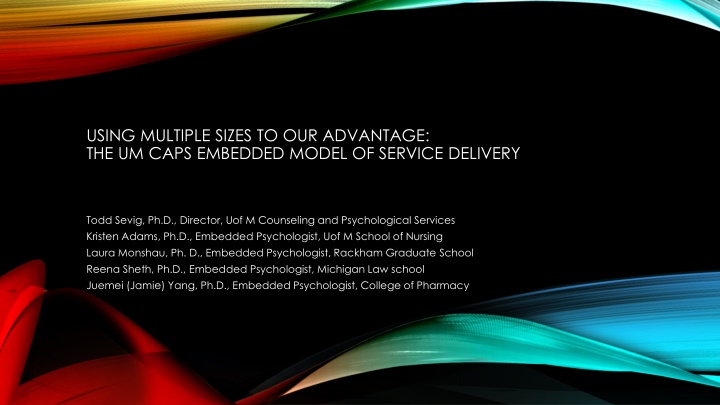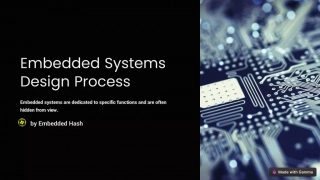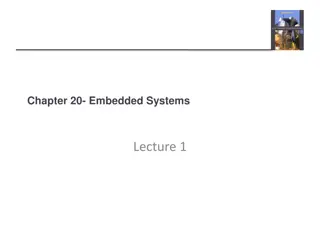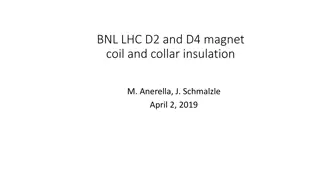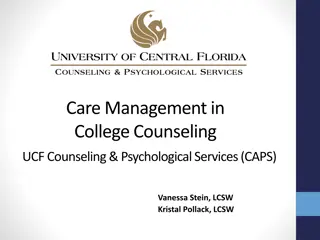UM Caps Embedded Model of Service Delivery
Enhancing service delivery through the UM Caps Embedded Model by Todd Sevig, Ph.D., and Kristen Adams. This innovative approach utilizes multiple sizes to optimize effectiveness in counseling and psychological services at the University of Michigan. The model emphasizes tailored support for diverse needs, fostering holistic well-being among individuals. Discover how this model promotes comprehensive care and facilitates positive outcomes within a university setting.
Download Presentation

Please find below an Image/Link to download the presentation.
The content on the website is provided AS IS for your information and personal use only. It may not be sold, licensed, or shared on other websites without obtaining consent from the author.If you encounter any issues during the download, it is possible that the publisher has removed the file from their server.
You are allowed to download the files provided on this website for personal or commercial use, subject to the condition that they are used lawfully. All files are the property of their respective owners.
The content on the website is provided AS IS for your information and personal use only. It may not be sold, licensed, or shared on other websites without obtaining consent from the author.
E N D
Presentation Transcript
USING MULTIPLE SIZES TO OUR ADVANTAGE: THE UM CAPS EMBEDDED MODEL OF SERVICE DELIVERY Todd Sevig, Ph.D., Director, Uof M Counseling and Psychological Services Kristen Adams, Ph.D., Embedded Psychologist, Uof M School of Nursing Laura Monshau, Ph. D., Embedded Psychologist, Rackham Graduate School Reena Sheth, Ph.D., Embedded Psychologist, Michigan Law school Juemei (Jamie) Yang, Ph.D., Embedded Psychologist, College of Pharmacy
THEMES Genesis: Journey to the present and values animating the Embedded Model Commonalities and Differences: One size does not fit all Relationships and Partnerships: Walking the line of boundaries Collaboration: Within and Without Takeaways and Challenges: What is next?
GENESIS A Social Justice and Community-based model of care (Community of Care) CAPS 3Ms Value Foundation: Multi-cultural, Multi-disciplinary, Multi- theoretical A unique response to the trend of increasing student demand for mental health services A response to need voiced by Deans and faculty for more catered services to the unique needs of each individual school community
COMMONALITIES AND DIFFERENCES Statistics: Undergraduate/Graduate and Professional students, gender, types of programs in the school, presenting concerns, other trends Expertise Can give examples of how clinical, outreach, and consultation services are individualized for each school Highlight creativity, flexibility, artistry for each community s unique needs, connect with social justice (reducing stigma) and community-based model
RELATIONSHIPS AND PARTNERSHIPS Uniqueness of and need for building partnership with Liaisons/Student Life administrators, faculty, staff, and student group leaders Boundaries through confidentiality, collaboration, and challenges Examples: Consulting about students, outreach, office location, salary, etc. Unique Skills: Not just clinical but also public relations, diplomacy, creativity, and flexibility, learning the lingo
COLLABORATIONS: WITHIN AND WITHOUT With fellow embedded staff: supporting each other With CAPS central office: ongoing consultation, support, and bridging With administrators: Education of the role and limitations of the same
TAKEAWAYS AND CHALLENGES Takeaways For fellow embedded clinicians For administrators working with or hoping to work with embedded staff Takeaways for Planners (hoping to start embedded) Challenges Funding Expectations Future in the context of stepped care
